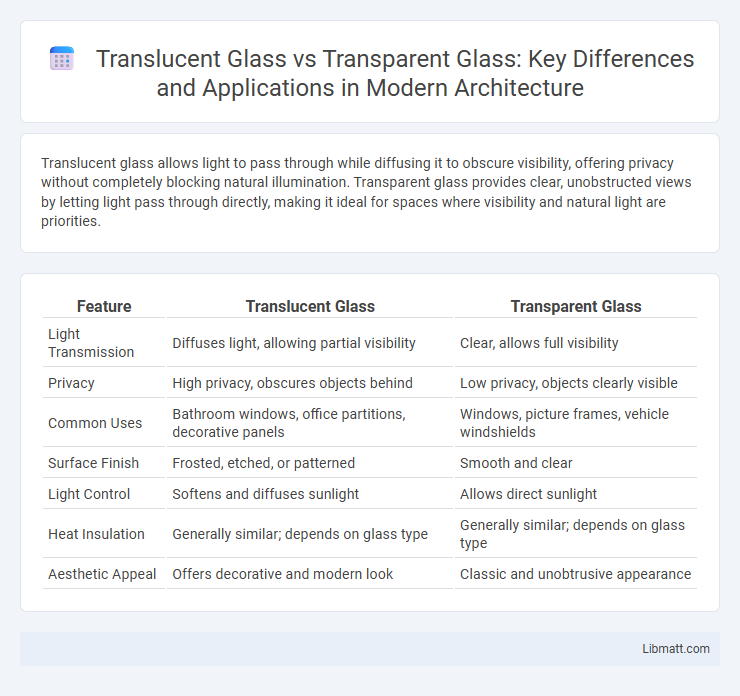Translucent glass allows light to pass through while diffusing it to obscure visibility, offering privacy without completely blocking natural illumination. Transparent glass provides clear, unobstructed views by letting light pass through directly, making it ideal for spaces where visibility and natural light are priorities.
Table of Comparison
| Feature | Translucent Glass | Transparent Glass |
|---|---|---|
| Light Transmission | Diffuses light, allowing partial visibility | Clear, allows full visibility |
| Privacy | High privacy, obscures objects behind | Low privacy, objects clearly visible |
| Common Uses | Bathroom windows, office partitions, decorative panels | Windows, picture frames, vehicle windshields |
| Surface Finish | Frosted, etched, or patterned | Smooth and clear |
| Light Control | Softens and diffuses sunlight | Allows direct sunlight |
| Heat Insulation | Generally similar; depends on glass type | Generally similar; depends on glass type |
| Aesthetic Appeal | Offers decorative and modern look | Classic and unobtrusive appearance |
Introduction to Translucent and Transparent Glass
Translucent glass diffuses light, allowing partial visibility while obscuring details, making it ideal for privacy in bathrooms or office partitions. Transparent glass provides clear, unobstructed views and maximum light transmission, commonly used in windows and display cases. Understanding the distinctions in light transmission and privacy benefits guides optimal glass selection for architectural and design applications.
Defining Translucent Glass
Translucent glass diffuses light, allowing visibility of shapes and colors without clear detail, unlike transparent glass which permits clear, unobstructed views. Commonly used in privacy applications, translucent glass combines natural light transmission with obscured visibility, enhancing both aesthetics and functionality. Materials such as frosted, sandblasted, or textured glass achieve translucency by altering the glass surface or incorporating additives that scatter light.
What is Transparent Glass?
Transparent glass is a type of glass that allows light to pass through with minimal distortion, enabling clear visibility of objects on the other side. It is commonly used in windows, eyeglasses, and display cases due to its high clarity and optical purity. The molecular structure of transparent glass is uniform, which reduces scattering and absorption of light waves.
Key Differences Between Translucent and Transparent Glass
Translucent glass diffuses light, allowing partial visibility while obscuring clear images, whereas transparent glass permits full light passage and clear visibility through it. The key differences lie in light transmission and privacy level, with translucent glass providing privacy without complete opacity and transparent glass offering unobstructed views. Applications vary accordingly, with translucent glass favored for privacy in bathrooms or office partitions, and transparent glass used in windows and glass doors for maximum clarity.
Light Transmission: Translucent vs Transparent
Translucent glass diffuses light, allowing partial light transmission while obscuring detailed views, making it ideal for privacy without sacrificing brightness. Transparent glass provides nearly 90-99% light transmission, offering clear visibility and natural lighting, perfect for windows and display cases. Your choice depends on balancing light clarity and privacy requirements in your space.
Common Applications of Translucent Glass
Translucent glass is widely used in office partitions, bathroom windows, and shower doors where privacy is essential while still allowing natural light to pass through. Its unique ability to diffuse light makes it ideal for skylights and decorative panels that soften harsh sunlight and reduce glare. You can enhance both aesthetics and functionality in your space by choosing translucent glass for applications requiring privacy without sacrificing illumination.
Popular Uses of Transparent Glass
Transparent glass is widely used in windows, automobile windshields, and smartphone screens due to its clarity and ability to provide an unobstructed view. It is essential in architecture for creating natural lighting and visual connection between indoor and outdoor spaces. Transparent glass also plays a critical role in optical instruments, greenhouses, and display cases, where visibility and light transmission are paramount.
Aesthetic and Privacy Considerations
Translucent glass offers a unique aesthetic by diffusing light and creating a soft, blurred effect that enhances privacy without sacrificing brightness, making it ideal for bathrooms, offices, and decorative partitions. Transparent glass, on the other hand, provides clear visibility and a sleek, modern look but offers little to no privacy, which may not suit spaces that require confidentiality. Choosing the right glass type depends on your balance between aesthetic preference and the level of privacy needed in your interior design.
Energy Efficiency and Thermal Performance
Translucent glass diffuses light while reducing solar heat gain, enhancing energy efficiency by minimizing the need for artificial cooling and lighting. Transparent glass allows maximum visible light transmission but often results in higher solar heat gain, which can increase cooling loads and reduce thermal performance. Energy-efficient glazing coatings applied to both types improve insulation properties, but translucent glass typically provides superior thermal comfort through controlled light diffusion.
Choosing the Right Glass for Your Project
Translucent glass diffuses light while obscuring visibility, providing privacy without sacrificing natural illumination, making it ideal for bathrooms, offices, or decorative partitions. Transparent glass offers clear visibility and maximum light transmission, suitable for windows, storefronts, and display cases where clarity and openness are essential. Choosing the right glass for your project depends on balancing privacy needs, light control, and aesthetic preferences to ensure functionality and design harmony.
translucent glass vs transparent glass Infographic

 libmatt.com
libmatt.com